by: Zack Muindre May 30th, 2018 comments:
By Peter Agenga and Lucy Fondo
The month of April was bound to be a busy month for the Map Kibera team since we were to conduct a training and mapping exercise in Makueni County. This was in support of the Public Participatory Budgeting program, which is a program in several counties in Kenya allowing citizens to determine collaboratively the spending of a portion of the county’s development budget. Because communities decide on needs and priorities themselves, there was a need for up-to-date maps that could show them existing resources and assist with planning. As well, the counties were in need of maps to show exactly where those projects they had funded were located, and their condition and status.
Supported by the World Bank and facilitated by the Makueni County Government, the task at hand was to train the participants in creating maps with the use of various tools for data collection and editing like ODK (Open Data Kit) which is a mobile phone based application, GPS, OpenStreetMap (OSM), Java OpenStreetMap (JOSM) — all of which are very familiar to the team from Map Kibera.
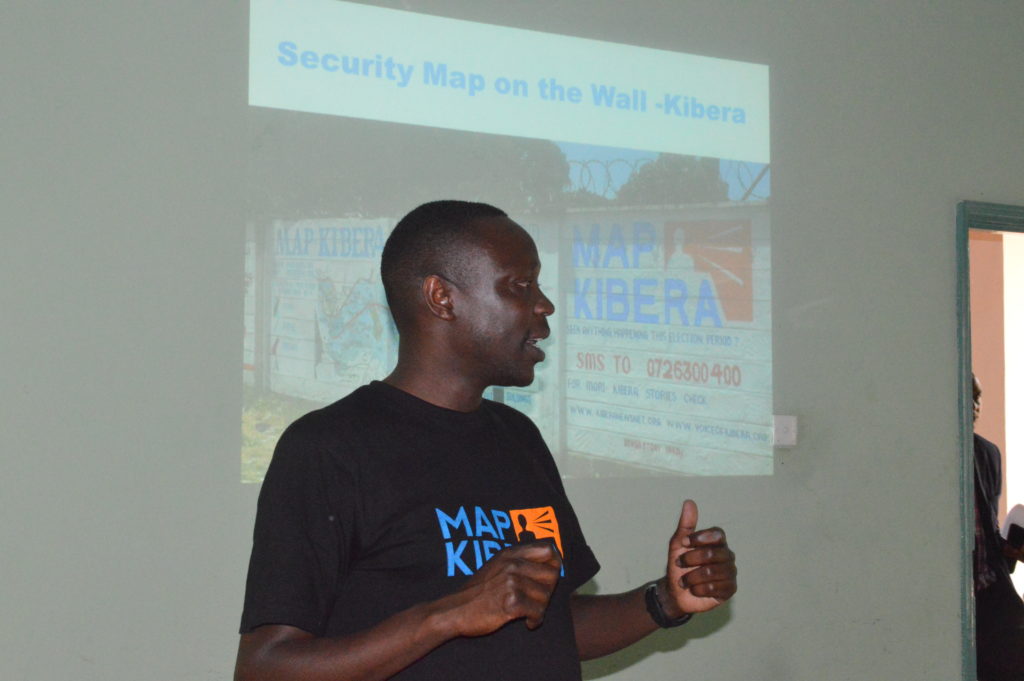
Joshua Ogure introducing the team to the work of Map Kibera Trust
On the first day of the assignment 16th April, we were all gathered at Acacia Hotel for the commencement of the training exercise for the participants in the entire mapping exercise. The number of the trainees was around twenty-six and gave us the impression that they were the most capable and devoted persons who were ready to learn and contribute towards achieving the project’s goals. They included Senior County Officials from the Finance and Planning Departments, the county Monitoring and Evaluation team, Interns from the various departments of the County Government, and village administrators.
The training started on a good note and Joshua Owino took the responsibility of introducing the Map Kibera Team by showcasing our various successful mapping projects like Open Schools Kenya. From the looks of the audience it was clear that mapping was a new and exciting venture in as far as data management is in the picture. The feedback from the trainees also gave us the notion that they were able to understand the diversity of map data and how the exercise would greatly contribute not only in highlighting the county projects but also the long-term aspect especially in assessments of other programs within the county.
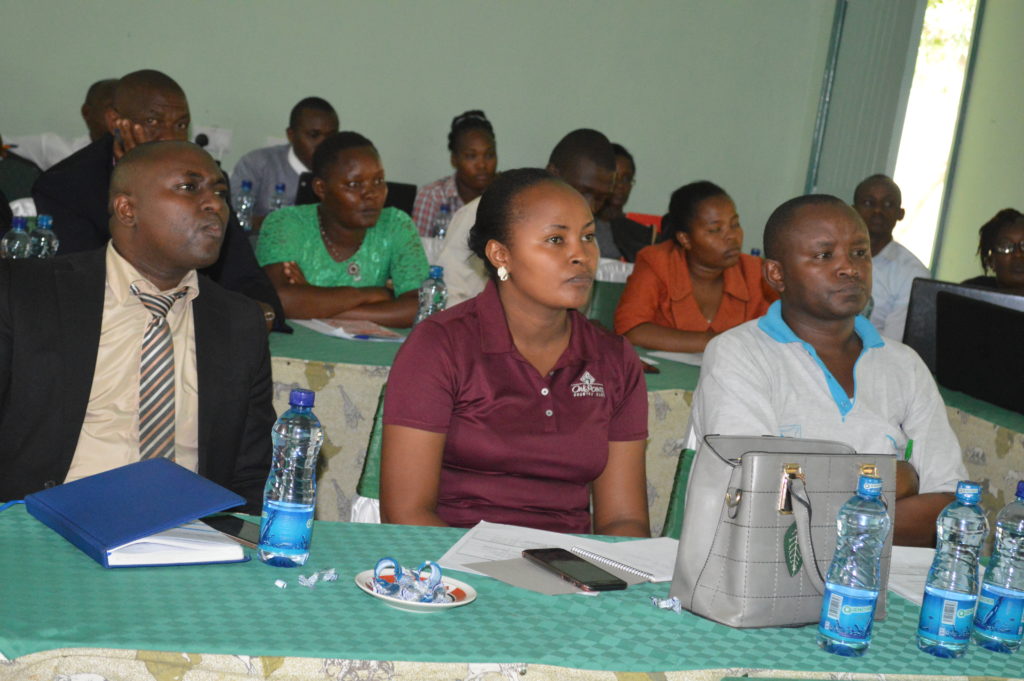
Mr. Eliud Ngila Munya Chief Officer, Planning. Makueni County on the front left following the training keenly
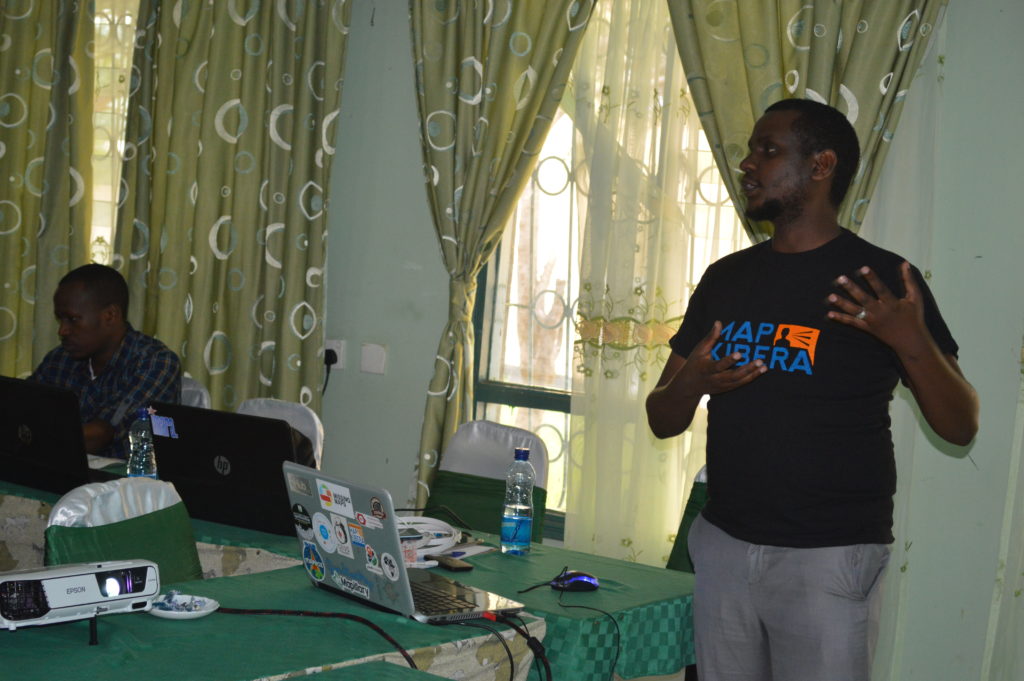
Zack Wambua from Map Kibera introducing the team to mapping using OpenStreetMap
With the training in motion, the first week saw the trainees learn about OpenStreetMap, JOSM, the GPS and ODK. The training also involved thorough practical sessions in data collection using the GPS and ODK followed by an editing exercise with the use of JOSM and OSM just to affirm that the trainees were well equipped in using the tools.
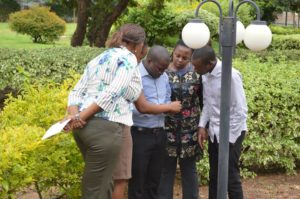
Some of the trainees having a short mapping exercise with assistance from Peter of Map Kibera on the far right within the training venue
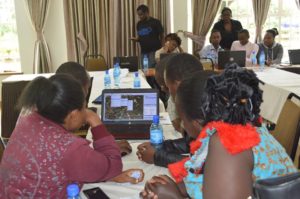
The team editing points they collected from the small mapping exercise
The first week objectives were fully achieved despite a few hitches especially with the internet connectivity. We tried to relocate to Kusyombunguo Hotel with the hope of accessing better internet service, but this was in vain. However we all managed to continue with our work with the weak internet signal and surprisingly a few trainees took the opportunity to use their own phones in availing the internet for all to access and complete the online tasks especially while working with OpenStreetMap’s ID editor which is an online editing platform.
The long awaited day finally arrived and the field mapping exercise started on the second week 22nd April which was a Monday. Our greatest fear was that the weather would interfere with the week’s program, but all was in place and we were well prepared to adjust our program in the case of heavy rains. The participants were divided into eight groups and assigned areas (villages) to cover in the mapping exercise. We also had to join some of the teams at intervals just to monitor their progress and give them moral support as we shared our field work experiences from previous mapping exercises.
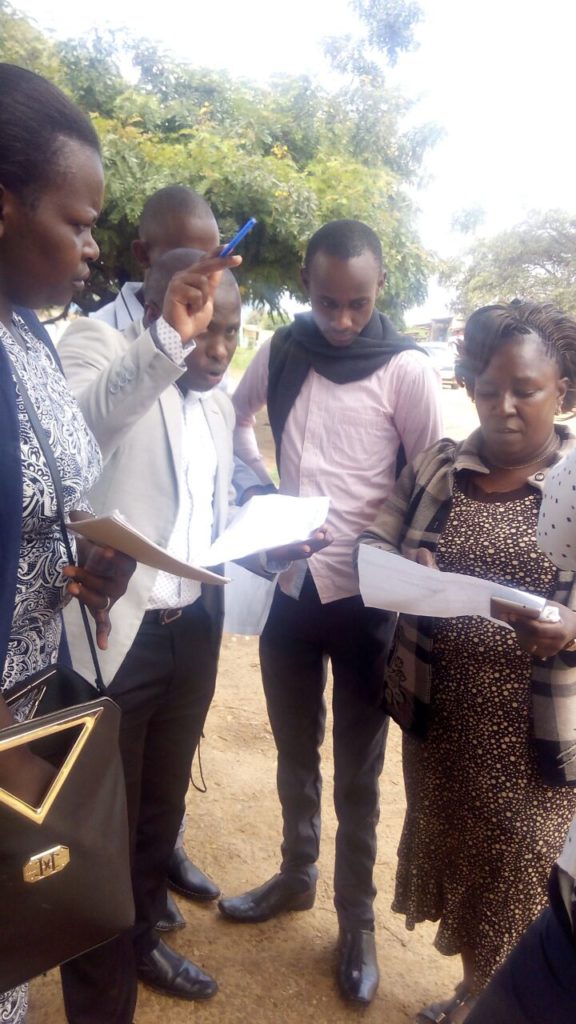
Nziu sub-ward admin on the far right drawing a route map for the team she was in charge of

Sam one of the interns from the County office collecting a point using GPS
As predicted, the following day saw heavy rainfall hinder our mapping exercise and we had to gather at Acacia Hotel to work on the edits of the data that was collected on the previous day. This was also followed by a lengthy session of reviewing the previous day’s work. A few changes had to be made in order to enhance our work, for example clarification of some areas/villages and features to avoid the teams overlapping and duplication of work. The participants were also urged to proceed with caution since the heavy rains wreaked havoc in some areas.
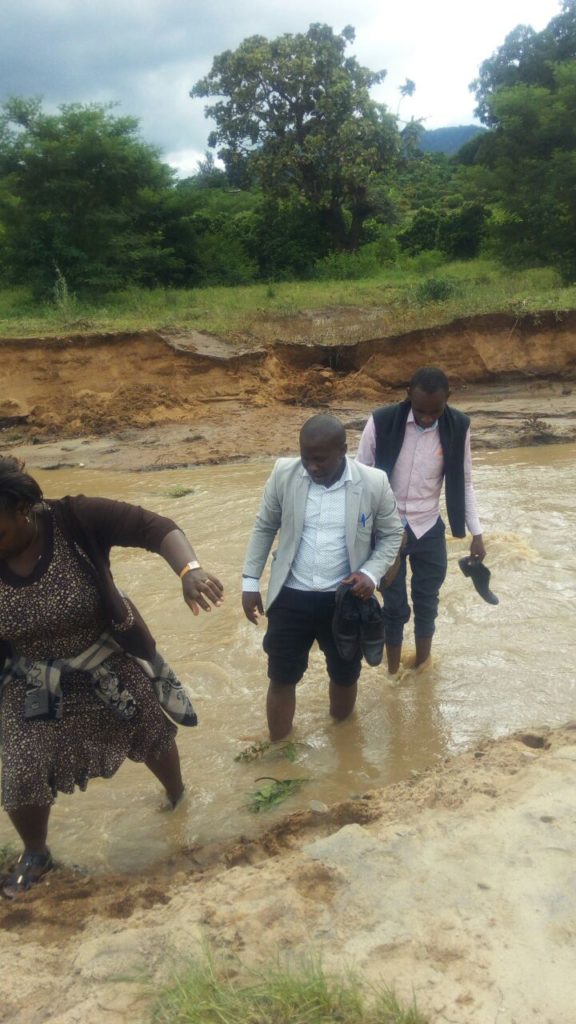
One of the teams crossing a river in order to access points that are on the other side
The remaining days were fruitful as the participants had proven that they were thorough in the field exercise and they were also able to edit the data with minimal supervision from the Map Kibera team. However, some of them were not prepared physically for the mapping exercise and we could hear them complaining about exhaustion and muscle cramps. The terrain of the area was also a factor, especially for the team that covered Nziu area which was mountainous and full of streams that they had to cross eventually. All in all the mapping exercise was quite involving and productive as expected, and it is only through such experiences that people appreciate the work that Map Kibera does in availing data to the public and other interested parties through maps.
After the successful work in Wote ward, Map Kibera proceeded to Mbooni Ward to conduct another training to community members/volunteers, despite the work being delayed for two weeks due to the heavy rains as well as the county’s commitment to other activities. The exercise was part of the larger mapping that was in line with the PB program, with the two wards Wote and Mbooni being the target areas for the pilot. The team from Mbooni was comprised of seven youth residents of the ward — three young women and three young men and their leader who was also the sub-ward administrator for Mbooni ward.
To facilitate the exercise, six members from the previous mapping exercise in Wote ward joined their counterparts in Mbooni. The added personnel would be key in covering more ground and hastening the field exercise that was scheduled to start on Friday 18th May on the same week. With everything in place, the training went on well on the first day and the team of seven from Mbooni ward were quick to grasp the exercise as shown by their time keeping and response to the short data collection exercise they conducted that afternoon.
The second day of the training was on Thursday 17th May, and the day started with one of the most annoying challenges common in Africa and that was a blackout. Most of the training equipment rely heavily on power and a blackout would be a huge drawback to the exercise. Because of the fact that there was no back up for electricity, the training session became a lecture conducted by the team leader Zachariah while two laptops with full battery were used for demonstration and practice. The trainees were also forced to be attentive for the two hours of learning about JavaScript OpenStreetMap (JOSM). This was followed by an editing session of the data they had collected on the previous day’s short mapping exercise.
We managed to conquer the challenges faced on the second day of training and the team from Mbooni had a chance to prove that they had leant something from the two days of training. The big day had finally arrived and six teams comprising of both participants from Wote and Mbooni wards were assigned different villages to cover. This mapping exercise was able to benefit from learnings from the previous exercise in Wote, with an emphasis on the allocation of villages to avoid the possibility of overlapping and teams mapping the same features. This was made simple by the ward and village administrators who were thorough in their coordination efforts, and they also went further to alert the authorities and village elders who would offer more assistance to the mappers on the ground. The day came to a successful end. An extra day was added in order to allow for more time for the mapping exercise to be completed.
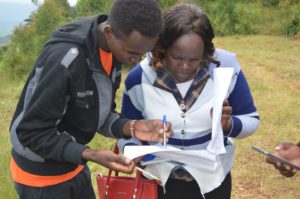
Elizabeth (in white), Kyuu/Nzeveni sub-ward and the current acting Mbooni Ward admin, assisting the team in the field to locate the points.
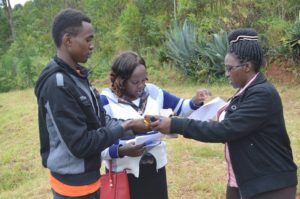
Mbooni is a hilly place that is riddled with hardship and it appears dry and surprisingly cold even during the day. The team from Mbooni were well aware of this and were it not for their wardrobe advice then the rest of us would be toast. On Monday 21st all the teams met at the sub-ward administrator’s office prior to the mapping exercise. We had a short recap session and the teams were sent out to complete the remaining areas. We also came to realize that Mbooni is well endowed with natural resources and beautiful scenes that would distract you in the field. The presence of more than five dams, rivers as well streams was a clear indication of the bounty resources in the area. Another thing worth noting were the planted forests in the place, for harvesting wood.
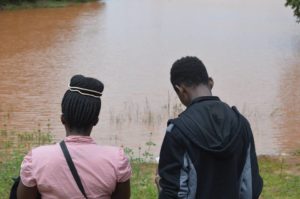
One of the team mapping an earth dam
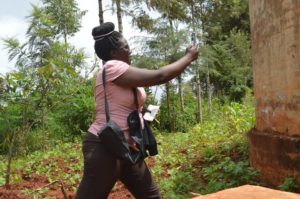
Ruth, one of the trainees taking a photo of a point.
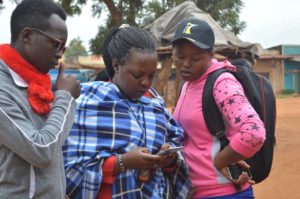
Mobile data collection using ODK
The mapping exercise came to an end on Tuesday 22nd, with all the teams having exhausted all the features that had to be mapped in the area. After the intensive three day field work, the teams were ordered to meet at Kusyombunguo Hotel on the following day for data editing. The editing session at Kusyombunguo Hotel went smoothly with minimal intervention from the Map Kibera team since the team from Wote and Mbooni joined forces in editing their work. At this point they were all well conversant on using JOSM. This was also a great time to reflect on the their experiences during the mapping exercise with most of them citing the treacherous routes they would take in order to reach areas that were inaccessible by both vehicles and motorcycles. Funny enough, the team from Mbooni never really complained about physical exhaustion unlike the rest of us, maybe we had not faced half of what they usually face on a daily basis.
The end of the editing exercise was marked by a group photo shoot and we bid each other goodbye.
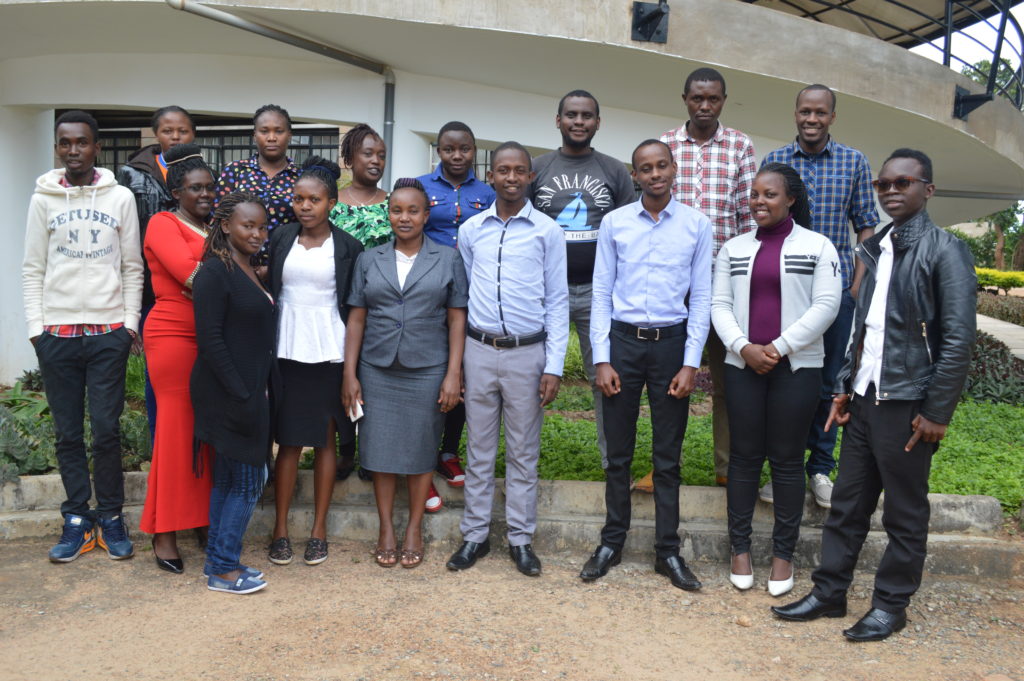
Group photo of the team from Mbooni and Wote
by: Zack Muindre January 11th, 2018 comments:
As the year 2018 has just began, everyone is busy writing resolutions, some reviewing what worked last year and what they need to change while others are writing new resolutions for the year. We at Map Kibera also took time to reflect on how the year 2017 was for us in terms of the work that we were able to do.
Security mapping/election monitoring
Una Hakika Project
The year began on a good note with the team in Map Kibera conducting a baseline survey for a project that they would be implementing in Kibera in partnership with the Sentinel Project. The project was dubbed Una Hakika? (Are you sure?), and the aim of the project was to assess and moderate the spread of rumours before, during and after the August election.

Una Hakika launch event at Undugu Ground in Kibera
With the August election drawing near, Map Kibera with the help of 3 students from University of Nairobi and JKUAT who were on internship through the Youth Mappers programme conducted a mapping exercise with the help of local community ambassadors drawn from the Una Hakika project.
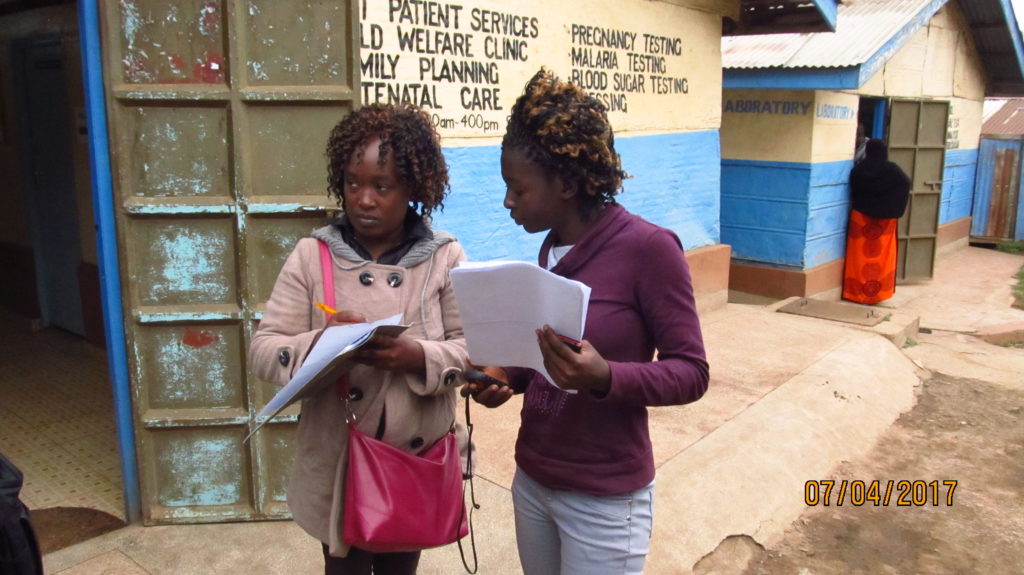
Lucy Fondo (on the left) and Phylister Mutinda collecting data in the field
This was to update the security map that was last updated during the 2013 elections. The printed copies of the maps were distributed to the local administrative officials as well as to NGOs that work in Kibera on peace initiatives.
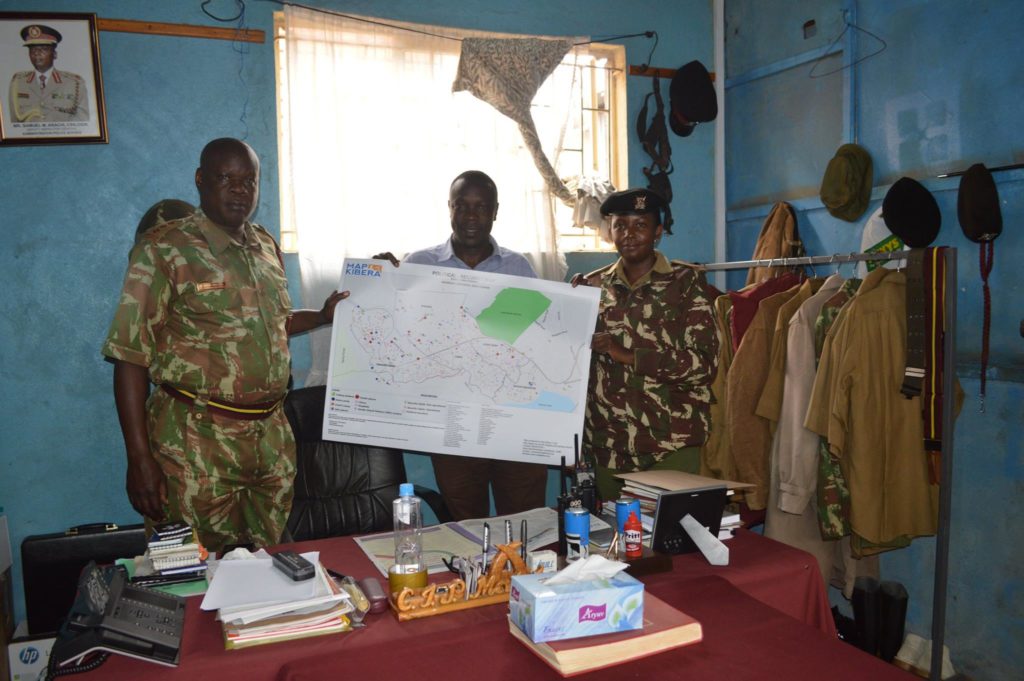
Joshua Ogure issuing a copy of the security map to Adminstration Police commandant
The other copies of the maps were distributed to community members. Read more here. The updated security map was also painted on the wall at a strategic point in Kibera where the community members and visitors would interact with it.
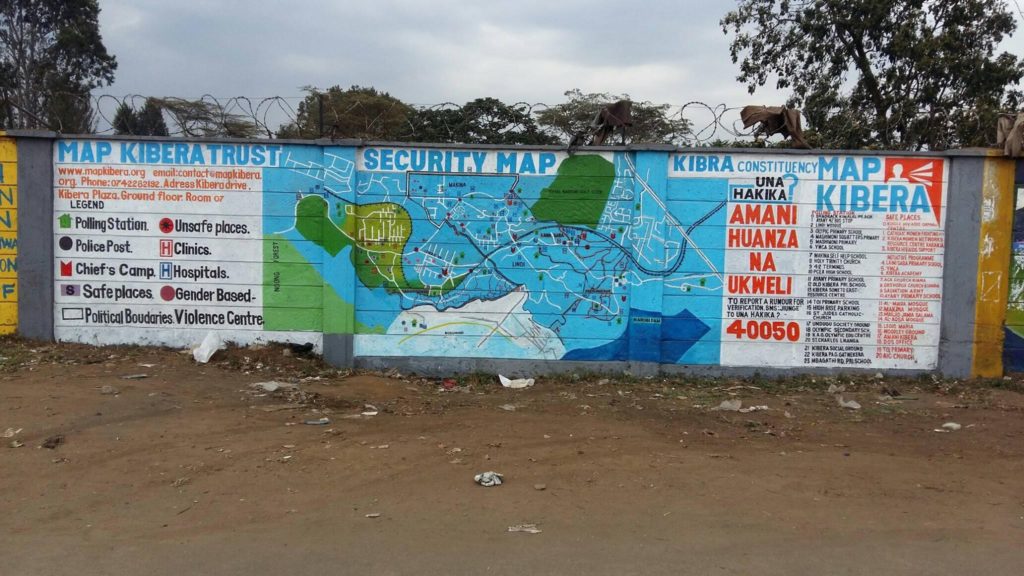
Updated Security map on the wall
During the August 8th election Map Kibera through the Una Hakika project also set up teams on various polling stations to report on the events as they were occurring. This was done through video coverage by the Kibera News Network team. The team was also supposed to report any issues by sending sms to the Una Hakika’s short code 40050.
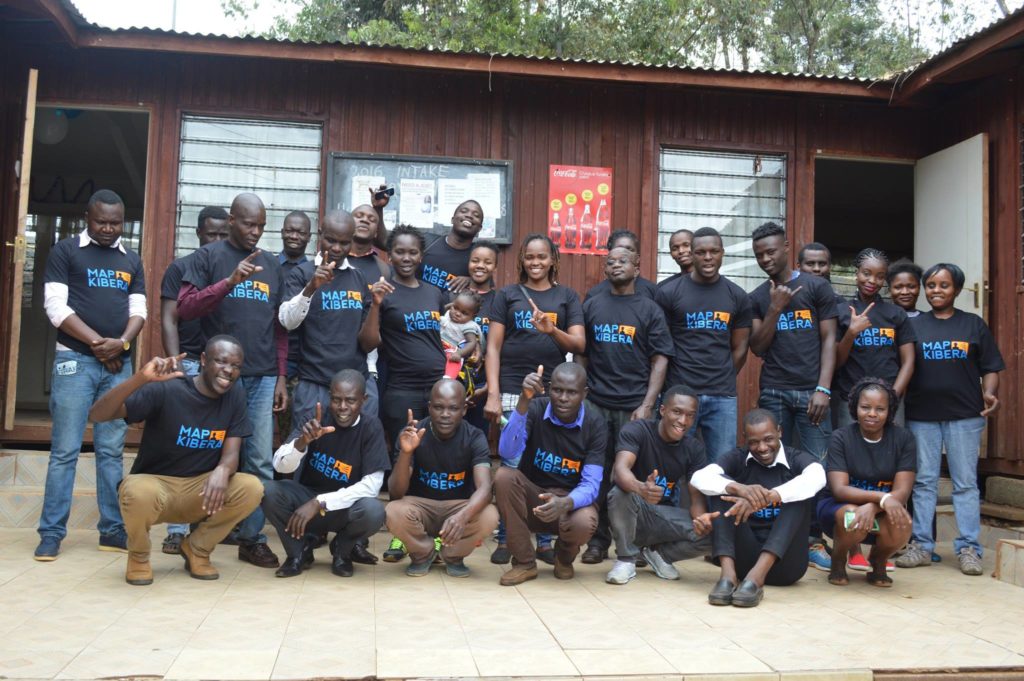
Citizen reporters trained for the elections
Video Coverage of Elections by KNN
The KNN team produced more than 50 videos for both August 8 elections and the repeat October 26 elections. At least one video went “viral” with more than 13,000 views: Kibera Supports Supreme Court Ruling.
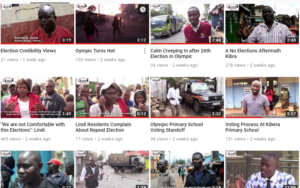
A screenshot of the videos produced by KNN during the election period
Repeat election
On 1st of October 2017 the Supreme Court Of Kenya nullified the August 8th Presidential election. The electoral body of Kenya was thereby asked to organize a fresh presidential election. This meant that our work on election monitoring wasn’t yet finished. So we organized and re-strategized to prepare for the fresh election. The period before the new set date for election saw a lot of demonstrations from the opposition team demanding changes on the electoral body before conducting another election. Kibera News Network documented some of these events, and even did interviews with some of the victims of police brutality after violence erupted immediately after Uhuru Kenyatta was declared the winner of the August 8th election. The IEBC set a new date for the repeat election to be 26th October. We monitored these elections afresh just as we did earlier.
Research
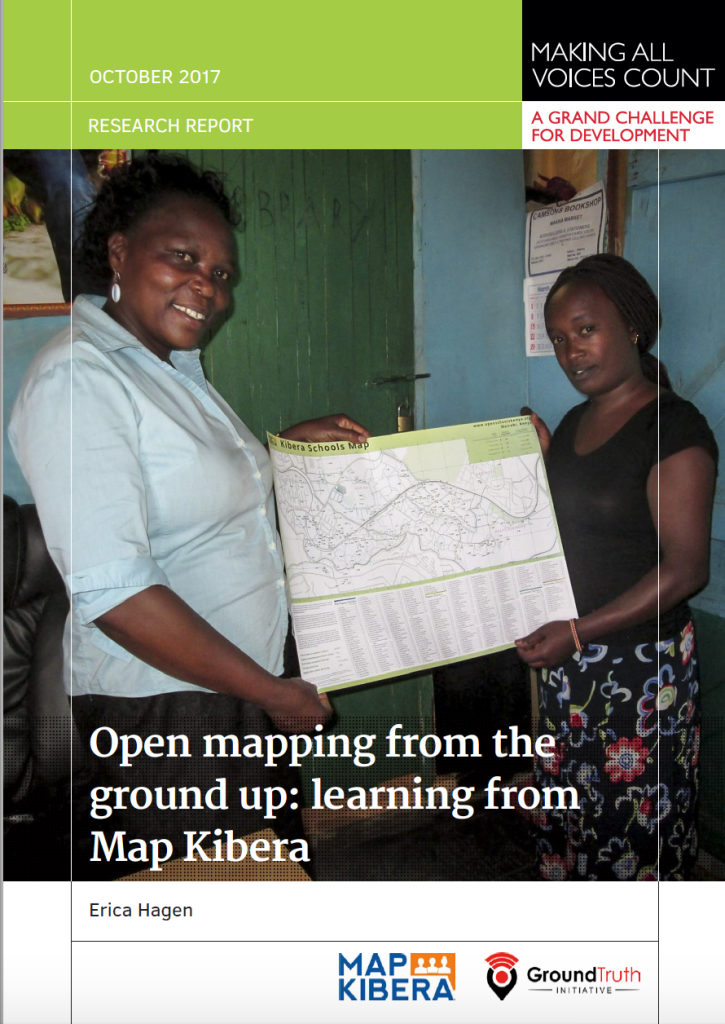 In the same year Erica Hagen, one of the co-founders of Map Kibera, was funded by Making All Voices Count to conduct a research on the impact of the work of Map Kibera in the local community and how the maps are being used by various local organizations, community based organizations, government offices and the community members. Key outcomes were that local officials had used our education maps to reach out to informal schools, build networks and extend resources to these schools. NGOs had also used other maps by Map Kibera to locate resources such as water and sanitation facilities. The research report can be read here.
In the same year Erica Hagen, one of the co-founders of Map Kibera, was funded by Making All Voices Count to conduct a research on the impact of the work of Map Kibera in the local community and how the maps are being used by various local organizations, community based organizations, government offices and the community members. Key outcomes were that local officials had used our education maps to reach out to informal schools, build networks and extend resources to these schools. NGOs had also used other maps by Map Kibera to locate resources such as water and sanitation facilities. The research report can be read here.
Sharing, Participating, Collaborating
The year 2017 also saw Map Kibera being recognized and invited to attend various international and national events to share about their work. Some of the meetings were: the High-Level Meeting on Data for Development in Africa held by the Kenya Government and Global Partnership for Sustainable Development Data (GPSDD); Buntwani 2017 organized by Open Institute, Making All Voices Count, Dlad and Data Zetu in Dar es salaam; the Data Pop course at UN Headquarters in Nairobi, and a radio interview at IQRA FM.
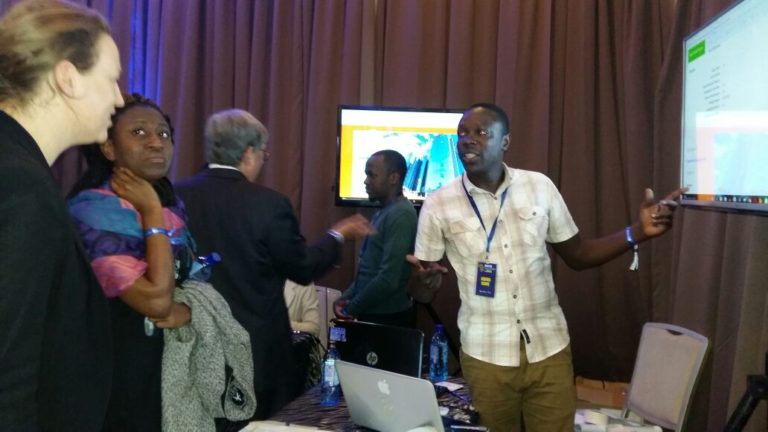
Joshua doing demonstration about Map Kibera and the open schools project at the High level meeting.
 ICT4D
For the second consecutive year Map Kibera has been invited to speak at the ICT4D conference. This year’s conference was held in Hyderabad, India and the theme for the conference was from innovation to impact. Zack Wambua represented the organization at the conference where he shared the impact of the Open Schools Kenya project. Zack also had an opportunity to visit one of the local organization Hyderabad Urban Lab to learn more about the work that they are doing around community participatory mapping in Hyderabad.
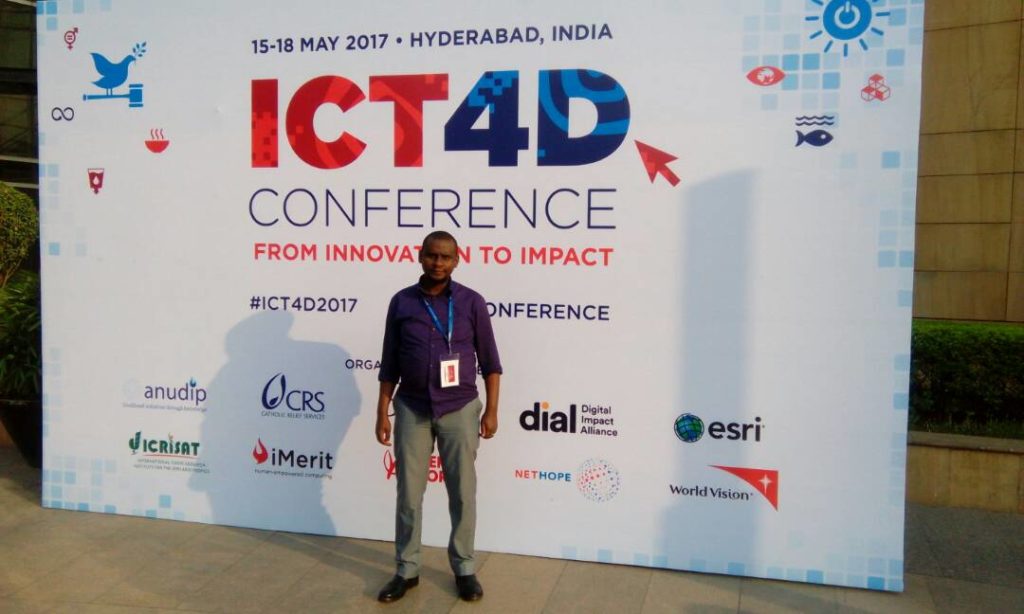
Zack Wambua at the ICT4D conference.
 State of the Map (SOTM) AFRICA
This was the first ever SOTM event to be held in Africa, and Map Kibera being one of the oldest users of OpenStreetMap in Africa were invited to share about their work on community mapping, a model that has been borrowed by many groups and organizations that use OSM. Joshua Ogure the project manager of Map Kibera travelled to Kampala, Uganda to represent the organization at the event. Read more here  http://www.mapkibera.org/blog/2017/07/21/my-experience-at-the-first-state-of-the-map-africa/
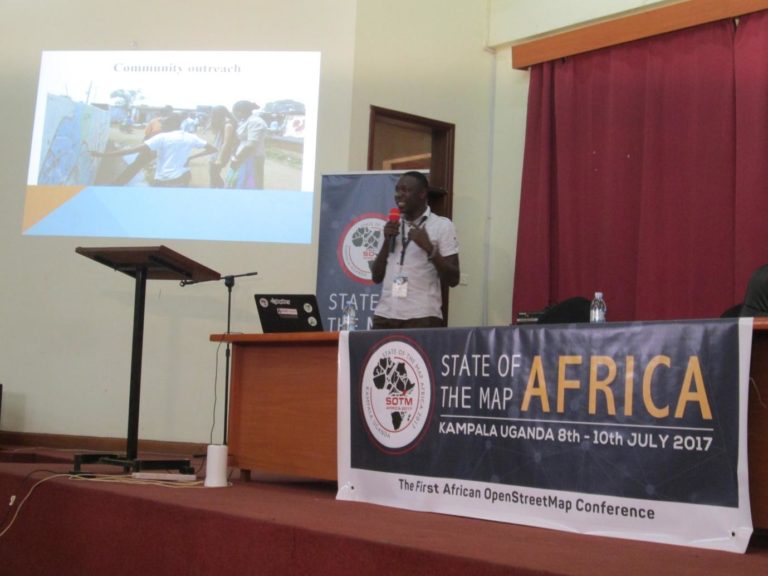
Joshua Presenting Map Kibera at SOTM Africa Kampala
SOTM Tanzania
After the successful SOTM Africa event, OSM teams in Tanzania led by Crowd2Map and Ramani Huria organized SOTM Tanzania. the event took place in Dar Es Salaam. Map Kibera was again called to assist with the planing of the event and also to share about their work during the conference. Zack Wambua travelled to Dar to represent the organization at the conference.

A group photo of all the attendees at SOTM Tanzania
Open Schools Kenya
In 2017Â Map Kibera kept up with changes to the Open Schools Kenya data. We along with our interns checked if the schools were still in the same location and if they had moved, we collected coordinates of their new location and updated the details on the site. We were also able to update school populations (for both teachers and students), changes in school management as well as any other co-curriculum activities that are offered in the schools. This was followed by an update to the website, where we added a search by location filter which enables you to view the schools’ data in both Kibera and Mathare, the two locations that we have rolled out the OSK work. Look for more changes and additional locations in OSK in 2018!
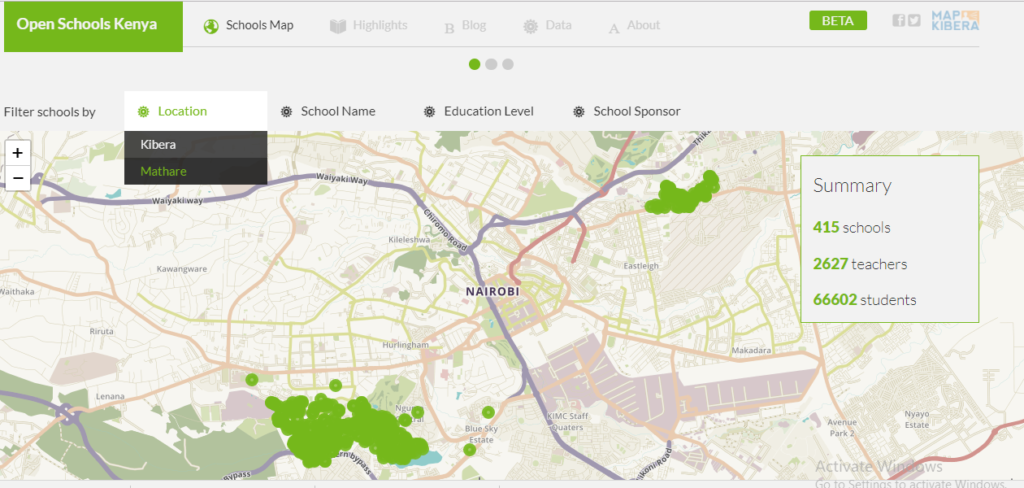
A screenshot of the updated Open Schools Kenya website with the new search by location feature
by: Zack Muindre August 30th, 2017 comments:
MAPATHON AT YALI REGIONAL LEADERSHIP CENTER
A Mapathon was held at Young African Leadership Initiative Regional Leadership Center in Kenyatta University, Kenya on June 27, 2017. It brought together Youth Mappers and participants from YALI Alumni, The University of Nairobi, Dedan Kimathi University, Jomo Kanyatta University of Agriculture and Technology and Kenyatta University. The event was facilitated by Map Kibera Trust and hosted by YALI.
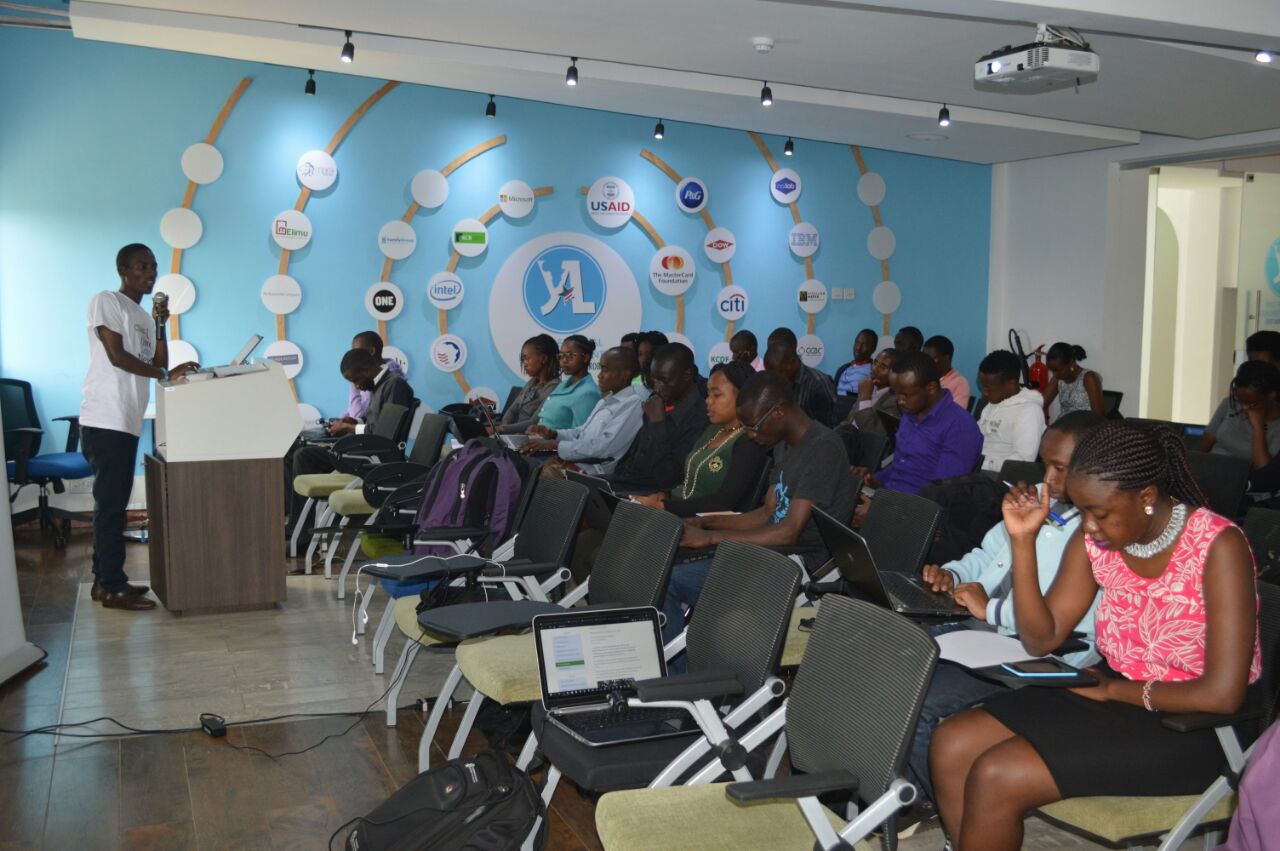
The Mapathon was aimed towards contributing in a mapping project to assist in the fight against AIDS and Malaria in Siaya (Bondo) using OpenStreetMap. The Mapathon is designed to improve availability of geographic data for programs supported by PEPFAR, (U.S. President’s Emergency Plan for AIDS Relief). The Mapathon also took place in advance of a high level conference in Nairobi on Data for Sustainable Development in Africa which was organized by The Global Partnership for Sustainable Development, which brought together participation of senior government officials across the region and globally.
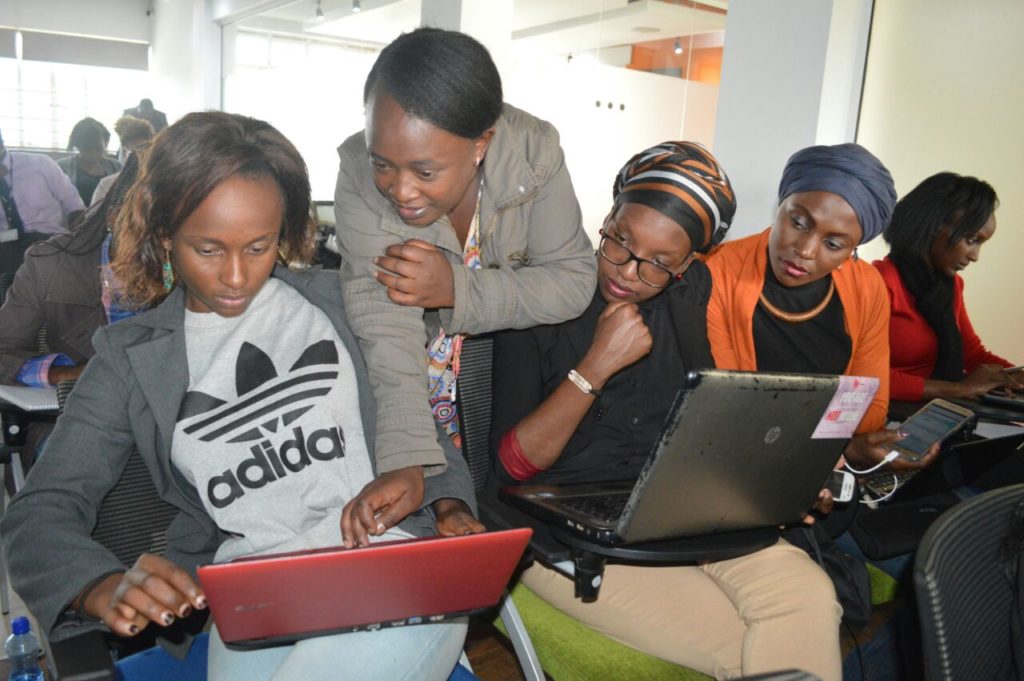
What is a Mapathon? It is a coordinated mapping event where the public is invited to make online map improvements in their local areas as well as areas across borders to improve coverage and help in areas such as disaster risk assessment. Mapathons basically use online sites for storing map data. In our case we use OpenStreetMap. Mapathons also help in contributing to missing maps as well as being a unique and engaging opportunity for volunteers to digitally connect and map most vulnerable places in the developing world, so that the local and international NGOs can use these comprehensive maps and data to better respond to crises affecting these areas.
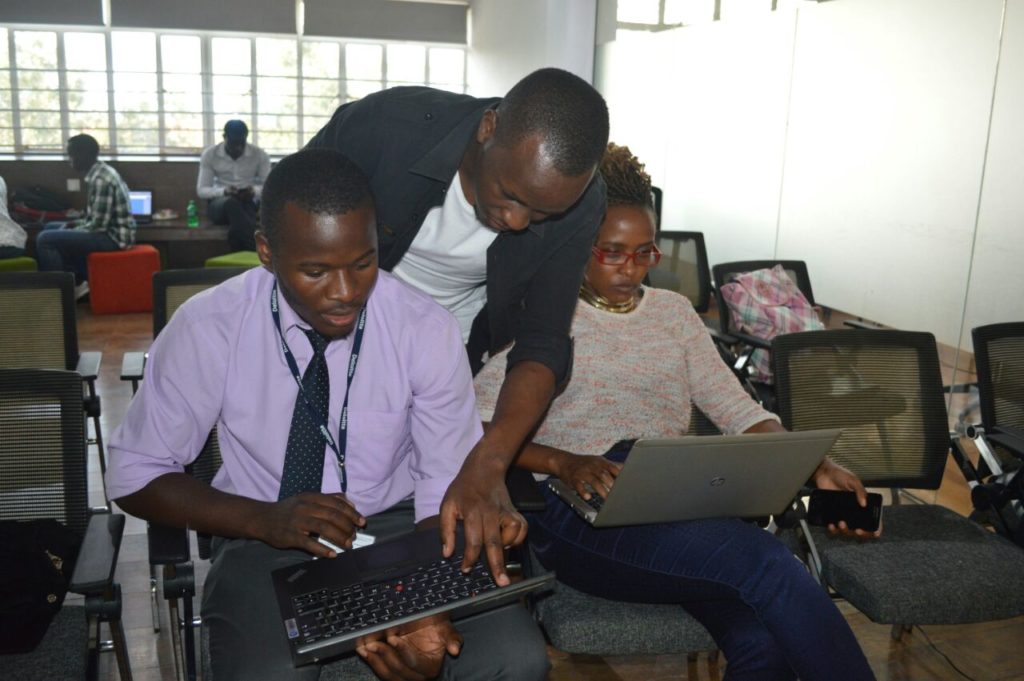
HIGH LEVEL MEETING FOR DATA AND DEVELOPMENT IN AFRICA
The world is rapidly changing especially towards Information and Technology. To run societies effectively, governments and all stakeholders are increasingly working towards getting quicker solutions to highlight and solve societal problems. This has been made easier by the use of data in order to capture , store, analyze and present different parameters of interest in different sectors of economies and society. Data has therefore been embraced with this respect.
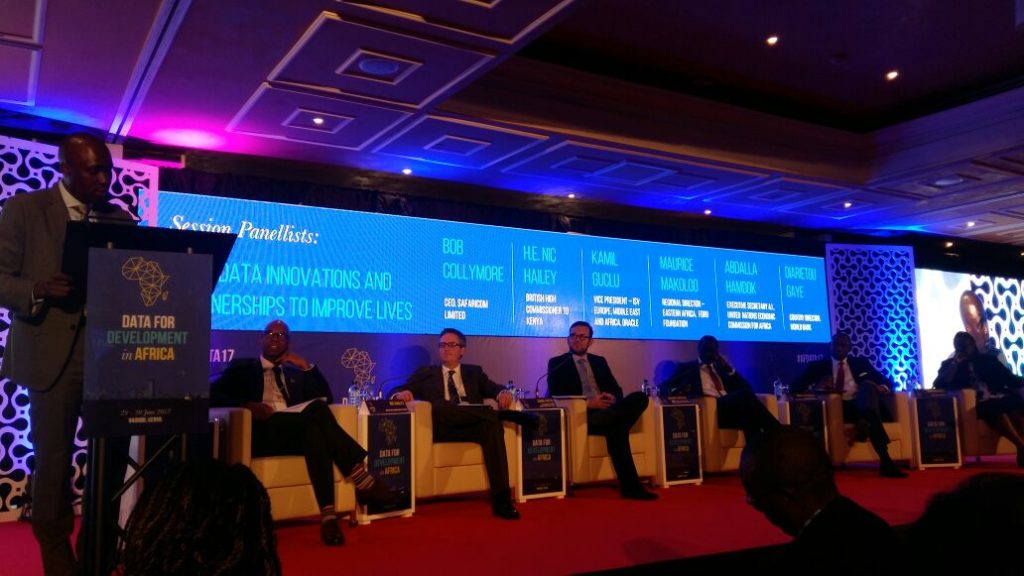
Data for Development in Africa was an important meeting that saw different governments and institutions come together in order to create a common ground to be able to achieve Sustainable Development Goals, that offer a pathway for countries, especially developing ones, to achieve development at both Economic and Social levels. The meeting was held for two days 29th-30th June 2017 in Nairobi. The theme was ‘Unleashing the Power of Data & Partnerships for Africa’. Among the key topics of the day were: Data for Agriculture, Livelihoods and Economy; Using data innovations and partnerships to improve lives; Mainstreaming data innovation at National level; Accessing vital services; data that leaves no- one behind; New skills for new data needs; developing home grown talent; Developing Institutional and Human capabilities. In line with the topics of the day, the first day of the meeting saw the various speakers highlight how data was central in service delivery, research work and generally on addressing human and environmental issues. African countries were the best example as they offered insight to the use of data at both local and national level.
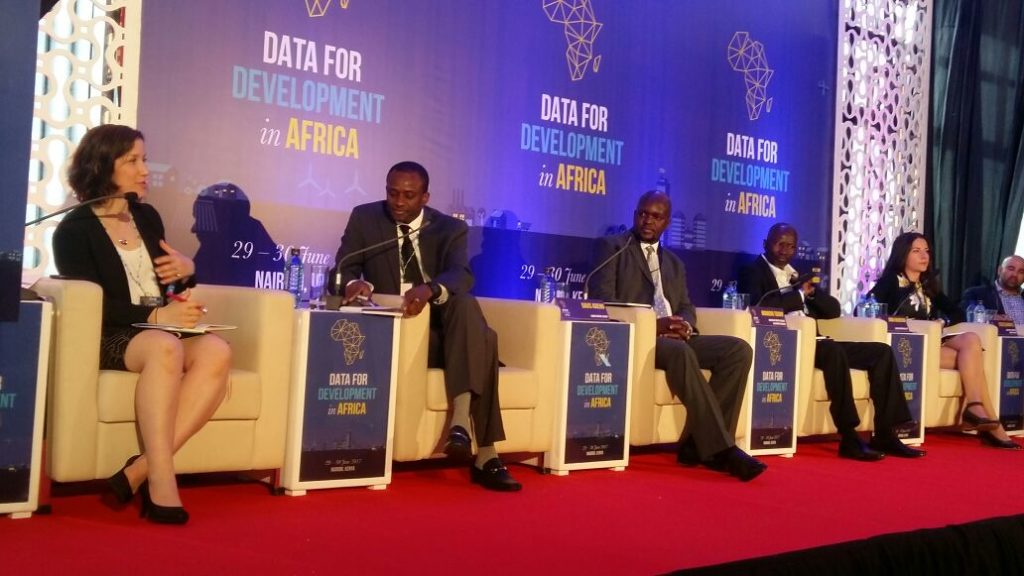
The second day of the meeting focused on the implementation of the data revolution as the multi-stakeholder panel discussed with the audience on how tools, technologies, hubs and approaches to take forward the discussion from the previous day. Different organizations were also given the opportunity to showcase their work with respect to the use of data in highlighting and addressing societal challenges for the realization of development in Africa. This saw our organization, Map Kibera Trust, attract positive attention on our effort to map social amenities in the slums of Kibera and basically offering great insight to the gradual development of the region over the past decade. This was also a great opportunity to share our partnership and joint works with the Youth Mappers in the recent past, and showcase our assistance in mapathons especially towards the fight against the spread of HIV & AIDS, environmental disasters and malaria.
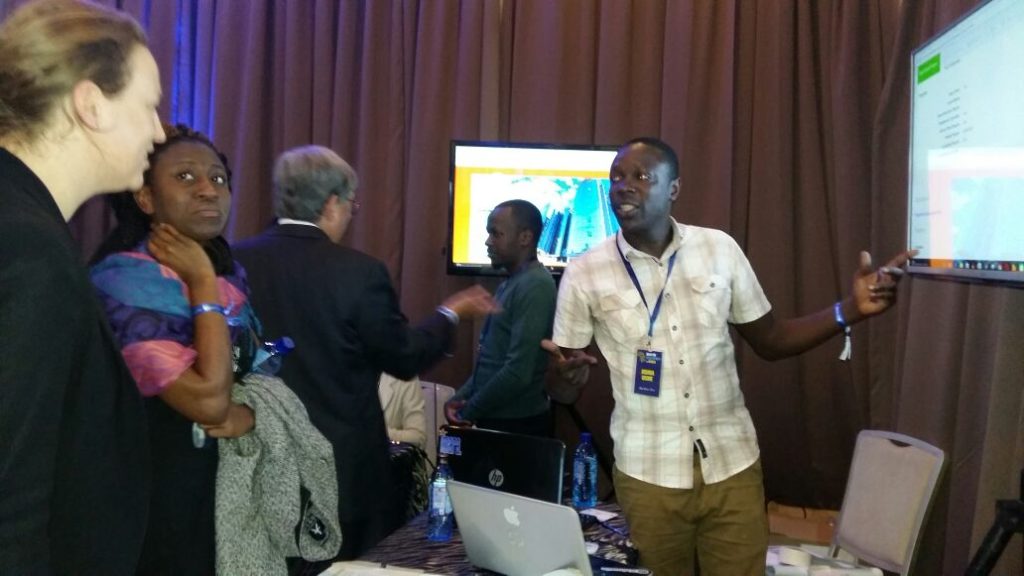
We thank The Government of Kenya and The Global Partnership For Sustainable Development for facilitating the High Level meeting. It is through such efforts that a common ground is created to allow for the bridging of gaps between Public, Private and Non Governmental Organizations to work towards a common goal.
Guest post by Phylister Mutinda and Peter Agenga from University of Nairobi Youth Mappers































